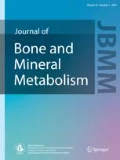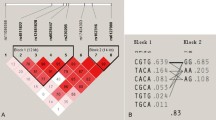Abstract
Contrary to the traditional belief that obesity acts as a protective factor for bone, recent epidemiologic studies have shown that body fat might be a risk factor for osteoporosis and bone fracture. Accordingly, we evaluated the association between the phenotypes of osteoporosis or vertebral fracture and variants of obesity-related genes, peroxisome proliferator-activated receptor-gamma (PPARG), runt-related transcription factor 2 (RUNX2), leptin receptor (LEPR), and adiponectin (ADIPOQ). In total, 907 postmenopausal healthy women, aged 60–79 years, were included in this study. BMD and biomarkers of bone health and adiposity were measured. We genotyped for four single nucleotide polymorphisms (SNPs) from four genes (PPARG, RUNX2, LEPR, ADIPOQ). A general linear model for continuous dependent variables and a logistic regression model for categorical dependent variables were used to analyze the statistical differences among genotype groups. Compared with the TT subjects at rs7771980 in RUNX2, C-carrier (TC + CC) subjects had a lower vertebral fracture risk after adjusting for age, smoking, alcohol, total calorie intake, total energy expenditure, total calcium intake, total fat intake, weight, body fat. Odds ratio (OR) and 95 % interval (CI) for the vertebral fracture risk was 0.55 (95 % CI 0.32–0.94). After adjusting for multiple variables, the prevalence of vertebral fracture was highest in GG subjects at rs1501299 in ADIPOQ (p = 0.0473). A high calcium intake (>1000 mg/day) contributed to a high bone mineral density (BMD) in GT + TT subjects at rs1501299 in ADIPOQ (p for interaction = 0.0295). Even if the mechanisms between obesity-related genes and bone health are not fully established, the results of our study revealed the association of certain SNPs from obesity-related genes with BMD or vertebral fracture risk in postmenopausal Korean women.


Similar content being viewed by others
References
Guney E, Kisakol G, Ozgen G, Yilmaz C, Yilmaz R, Kabalak T (2003) Effect of weight loss on bone metabolism: comparison of vertical banded gastroplasty and medical intervention. Obes Surg 13:383–388
Radak TL (2004) Caloric restriction and calcium’s effect on bone metabolism and body composition in overweight and obese premenopausal women. Nutr Rev 62:468–481
Wardlaw GM (1996) Putting body weight and osteoporosis into perspective. Am J Clin Nutr 63:433S–436S
Hsu YH, Venners SA, Terwedow HA, Feng Y, Niu T, Li Z (2006) Relation of body composition, fat mass, and serum lipids to osteoporotic fractures and bone mineral density in Chinese men and women. Am J Clin Nutr 83:146–154
Janicka A, Wren TA, Sanchez MM, Dorey F, Kim PS, Mittelman SD (2007) Fat mass is not beneficial to bone in adolescents and young adults. J Clin Endocrinol Metab 92:143–147
Zhao LJ, Liu YJ, Liu PY, Hamilton J, Recker RR, Deng HW (2007) Relationship of obesity with osteoporosis. J Clin Endocrinol Metab 92:1640–1646
Moerman EJ, Teng K, Lipschitz DA, Lecka-Czernik B (2004) Aging activates adipogenic and suppresses osteogenic programs in mesenchymal marrow stroma/stem cells: the role of PPAR-gamma2 transcription factor and TGF-beta/BMP signaling pathways. Aging Cell 3:379–389
Berner HS, Lyngstadaas SP, Spahr A, Monjo M, Thommesen L, Drevon CA (2004) Adiponectin and its receptors are expressed in bone-forming cells. Bone 35:842–849
Cornish J, Callon KE, Bava U, Lin C, Naot D, Hill BL (2002) Leptin directly regulates bone cell function in vitro and reduces bone fragility in vivo. J Endocrinol 175:405–415
Luo XH, Guo LJ, Xie H, Yuan LQ, Wu XP, Zhou HD (2006) Adiponectin stimulates RANKL and inhibits OPG expression in human osteoblasts through the MAPK signaling pathway. J Bone Miner Res 21:1648–1656
Steppan CM, Crawford DT, Chidsey-Frink KL, Ke H, Swick AG (2000) Leptin is a potent stimulator of bone growth in ob/ob mice. Regul Pept 92:73–78
Executive Summary of The Third Report of The National Cholesterol Education Program (NCEP) (2001) Expert panel on detection, evaluation, and treatment of high blood cholesterol in adults (Adult Treatment Panel III). JAMA. 285:2486–2497
Ferrar L, Jiang G, Adams J, Eastell R (2005) Identification of vertebral fractures: an update. Osteoporos Int 16:717–728
Ribas-Barba L, Serra-Majem L, Roman-Vinas B, Ngo J, Garcia-Alvarez A (2009) Effects of dietary assessment methods on assessing risk of nutrient intake adequacy at the population level: from theory to practice. Br J Nutr 101:S64–S72
Bustamante M, Nogues X, Agueda L, Jurado S, Wesselius A, Caceres E (2007) Promoter 2–1025 T/C polymorphism in the RUNX2 gene is associated with femoral neck bmd in Spanish postmenopausal women. Calcif Tissue Int 81:327–332
Doecke JD, Day CJ, Stephens AS, Carter SL, van Daal A, Kotowicz MA (2006) Association of functionally different RUNX2 P2 promoter alleles with BMD. J Bone Miner Res 21:265–273
Rhee EJ, Oh KW, Lee WY, Kim SY, Oh ES, Baek KH (2006) Effects of two common polymorphisms of peroxisome proliferator-activated receptor-gamma gene on metabolic syndrome. Arch Med Res 7:86–94
Kiel D, Ferrari S, Cupples L (2005) Polymorphisms in the PPARγ gene influence bone density in humans. J Bone Miner Res 20:S234
Lee WY, Rhee EJ, Oh KW, Kim SY, Jung CH, Yun EJ (2006) Identification of adiponectin and its receptors in human osteoblast-like cells and association of T45G polymorphism in exon 2 of adiponectin gene with lumbar spine bone mineral density in Korean women. Clin Endocrinol (Oxf). 65:631–637
Zhang ZL, He JW, Qin YJ, Hu YQ, Li M, Liu YJ (2007) Association between SNP and haplotypes in PPARGC1 and adiponectin genes and bone mineral density in Chinese nuclear families. Acta Pharmacol Sin 28:287–295
Crabbe P, Goemaere S, Zmierczak H, Van Pottelbergh I, De Bacquer D, Kaufman JM (2006) Are serum leptin and the Gln223Arg polymorphism of the leptin receptor determinants of bone homeostasis in elderly men? Eur J Endocrinol 154:707–714
Fairbrother UL, Tanko LB, Walley AJ, Christiansen C, Froguel P, Blakemore AI (2007) Leptin receptor genotype at Gln223Arg is associated with body composition, BMD, and vertebral fracture in postmenopausal Danish women. J Bone Miner Res 22:544–550
Koh JM, Kim DJ, Hong JS, Park JY, Lee KU, Kim SY (2002) Estrogen receptor alpha gene polymorphisms Pvu II and Xba I influence association between leptin receptor gene polymorphism (Gln223Arg) and bone mineral density in young men. Eur J Endocrinol 147:777–783
Booth SL, Dallal G, Shea MK, Gundberg C, Peterson JW, Dawson-Hughes B (2008) Effect of vitamin K supplementation on bone loss in elderly men and women. J Clin Endocrinol Metab 93:1217–1223
Iwamoto J, Takeda T, Sato Y (2006) Role of vitamin K2 in the treatment of postmenopausal osteoporosis. Curr Drug Saf 1:87–97
Li R, Svenson KL, Donahue LR, Peters LL, Churchill GA (2008) Relationships of dietary fat, body composition, and bone mineral density in inbred mouse strain panels. Physiol Genomics 33:26–32
Reid IR, Ames R, Mason B, Reid HE, Bacon CJ, Bolland MJ (2008) Randomized controlled trial of calcium supplementation in healthy, nonosteoporotic, older men. Arch Intern Med 168:2276–2282
Song Y, Paik HY, Joung H (2008) Soybean and soy isoflavone intake indicate a positive change in bone mineral density for 2 years in young Korean women. Nutr Res 28:25–30
Ward WE, Fonseca D (2007) Soy isoflavones and fatty acids: effects on bone tissue postovariectomy in mice. Mol Nutr Food Res 51:824–831
Yazdanpanah N, Zillikens MC, Rivadeneira F, de Jong R, Lindemans J, Uitterlinden AG (2007) Effect of dietary B vitamins on BMD and risk of fracture in elderly men and women: the Rotterdam study. Bone 41:987–994
Zhu K, Bruce D, Austin N, Devine A, Ebeling PR, Prince RL (2008) Randomized controlled trial of the effects of calcium with or without vitamin D on bone structure and bone-related chemistry in elderly women with vitamin D insufficiency. J Bone Miner Res 23:1343–1348
Zhu K, Devine A, Dick IM, Wilson SG, Prince RL (2008) Effects of calcium and vitamin D supplementation on hip bone mineral density and calcium-related analytes in elderly ambulatory Australian women: a five-year randomized controlled trial. J Clin Endocrinol Metab 93:743–749
Sun X, Zemel MB (2007) Calcium and 1,25-dihydroxyvitamin D3 regulation of adipokine expression. Obesity (Silver Spring) 15:340–348
Conflict of interest
All authors state that they have no conflicts of interest.
Author information
Authors and Affiliations
Corresponding author
About this article
Cite this article
Kim, KC., Chun, H., Lai, C. et al. The association between genetic variants of RUNX2, ADIPOQ and vertebral fracture in Korean postmenopausal women. J Bone Miner Metab 33, 173–179 (2015). https://doi.org/10.1007/s00774-014-0570-1
Received:
Accepted:
Published:
Issue Date:
DOI: https://doi.org/10.1007/s00774-014-0570-1




